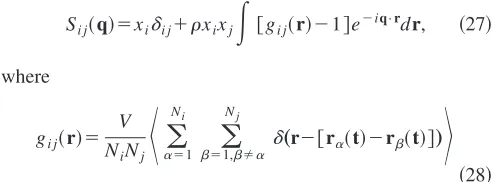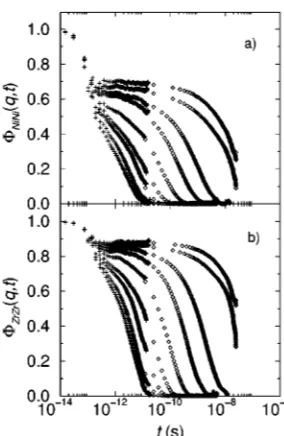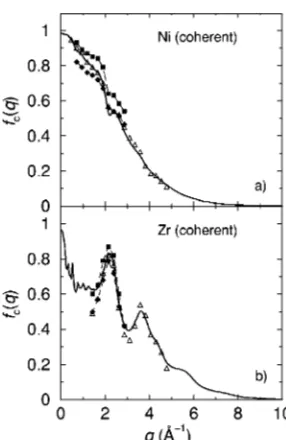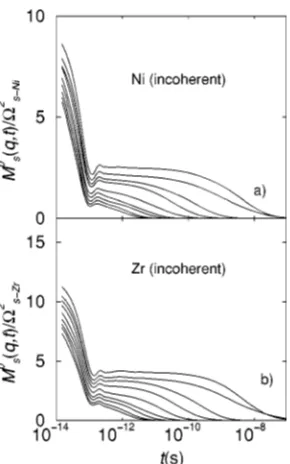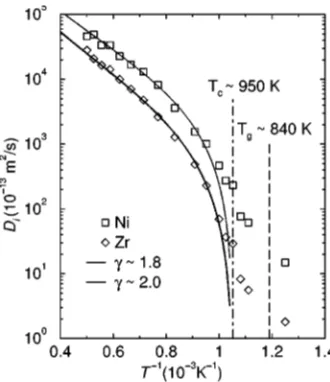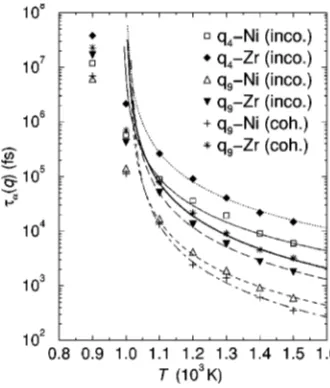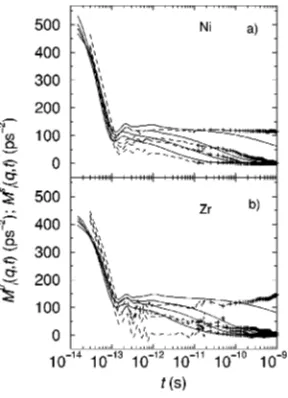Critical temperature
T
cand memory kernel in molecular-dynamics-simulated
glass-forming Ni
0.2Zr
0.8A. B. Mutiara*and H. Teichler†
Institut fu¨r Materialphysik, Universita¨t Go¨ttingen, Hospitalstrasse 3-7, D-37073 Go¨ttingen, Germany
~Received 20 July 2000; revised manuscript received 7 June 2001; published 26 September 2001!
The mode-coupling theory~MCT!of dense liquids marks the dynamical glass transition by a critical tem-peratureTcthat is reflected in the temperature dependence of a number of physical quantities. Here, molecular-dynamics simulation data of a model adapted to Ni0.2Zr0.8are analyzed to deduceTcfrom different quantities and to check the consistency of the estimated values. Analyzed are the critical temperatureTc from ~i! the nonvanishing nonergodicity parameters as asymptotic solutions of the MCT equations in the arrested state,~ii!
thegmparameters describing the approach of the melt towards the arrested state on the ergodic side,~iii!the diffusion coefficients in the melt, and~iv!the a-relaxation time. The resultingTcvalues are found to agree within about 10%. In addition, the time dependent memory kernel is calculated from the MCT for the inco-herent intermediate scattering function around Tc and compared with the kernel obtained by inverting the molecular dynamics data for the corresponding correlator.
DOI: 10.1103/PhysRevE.64.046133 PACS number~s!: 64.70.Pf, 61.20.Lc, 61.20.Ja, 02.70.Ns
I. INTRODUCTION
At present the phenomena behind the liquid-glass transi-tion and the nature of the glassy state are not fully under-stood, despite the progresses of recent years. In contrast to usual phase transformations the glass transition seems to be primarily dynamical in origin @1,2#and therefore new theo-retical approaches have to be developed for its description. Several theoretical models have been proposed to explain the transition and the corresponding experimental data. The lat-ter concern both the temperature dependence of particular properties, such as the shear viscosity and the structural re-laxation time, and the time dependent responseas visible in the dielectric susceptibility, inelastic neutron scattering, and light scattering spectra investigations. The spectral measure-ments have been extended to cover the large frequency range from below the primary a-relaxation peak up to the high-frequency region of microscopic dynamics dominated by vi-brational modes @3,4#.
One of the promising theoretical approaches in this field is the mode-coupling theory ~MCT!. The MCT originally was developed to model critical phenomena@5,6#. The non-classical behavior of the transport properties near the critical point was thought to be caused by nonlinear couplings be-tween slow ~hydrodynamic and order parameter! modes of the system. In later years, the MCT was found to be appli-cable more generally to describe nonlinear effects in dense liquids @7# and nonhydrodynamic effects in the case of the glass transition.
In its simplest~‘‘idealized’’!version, first analyzed in the ‘‘schematic’’ approach by Bengtzelius et al. @8# and inde-pendently by Leutheusser@9#, the MCT predicts a transition from a high temperature liquid ~‘‘ergodic’’! state to a low temperature arrested ~‘‘nonergodic’’! state at a critical
tem-perature Tc. Including transverse currents as additional
hy-drodynamic variables, the full MCT shows no longer a sharp transition atTcbut all structural correlations decay in a final
a process@2#. Similar effects are expected from inclusion of thermally activated matter transport, that means, diffusion in the arrested state @10,11#.
In the full MCT, the remainders of the transition and the value ofTchave to be evaluated, e.g., from the approach of
the undercooled melt towards the idealized arrested state, either by analyzing the time and temperature dependence in the b regime of the structural fluctuation dynamics@12–14# or by evaluating the temperature dependence of the so-called
gm parameter @15,16#. There are further possible ways to estimate Tc, e.g., from the temperature dependence of the
diffusion coefficients or the relaxation time of the final a decay in the melt, as these quantities for T.Tc display a
critical behavior uT2Tcu6g
. However, only crude estimates ofTccan be obtained from these quantities, since nearTcthe
critical behavior is masked by the effects of transverse cur-rents and thermally activated matter transport, as mentioned above.
On the other hand, as emphasized and applied in@17–19#, the value ofTcpredicted by the idealized MCT can be
cal-culated once the partial structure factors of the system and their temperature dependence are sufficiently well known. Besides temperature and particle concentration, the partial structure factors are the only significant quantities that enter the equations of the so-called nonergodicity parameters of the system. The latter vanish identically for temperatures above Tc and their calculation thus allows a rather precise
determination of the critical temperature predicted by the idealized theory.
At this stage it is tempting to consider how well the esti-mates of Tc from different approaches fit together and
whether the Tc estimate from the nonergodicity parameters of the idealized MCT compares to the values from the full MCT. Regarding this, we here investigate a molecular dy-namics~MD!simulation model adapted to the glass-forming
*Permanent address: Gunadarma University, Jln. Margonda
Ni0.2Zr0.8 transition metal system. The NixZr12x system is
well studied by experiments@20,21#and by MD simulations @22–30#, as it is a rather interesting system whose compo-nents are important constituents of a number of multicompo-nent ‘‘massive’’ metallic glasses. In the present contribution we consider, in particular, the x50.2 composition and con-centrate on the determination ofTcfrom evaluating and
ana-lyzing the nonergodicity parameter, thegm(T) parameter in
the ergodic regime, the diffusion coefficients, and the a-decay relaxation time.
In the literature, similar comparison of Tc estimates
al-ready exist@17–19#for two systems. The studies come, how-ever, to rather different conclusions. From MD simulations for a soft spheres model, Barrat and Latz@17#find an agree-ment between the different Tc estimates within about 15%. On the other hand, for a binary Lennard-Jones system, Nau-roth and Kob @19# get from their MD simulations a signifi-cant deviation between theTcestimates by about a factor of
2. Regarding this, the present investigation is aimed at clari-fying the situation for at least one of the important metallic glass systems.
Our paper is organized as follows: In Sec. II, we present the model and give some details of the computations. Section III gives a brief discussion of some aspects of the mode-coupling theory as used here. Results of our MD simulations and their analysis are then presented and discussed in Sec. IV.
II. SIMULATIONS
The present simulations are carried out as state-of-the-art isothermal-isobaric (N,T,p) calculations. The Newtonian equations ofN5648 atoms~130 Ni and 518 Zr!are numeri-cally integrated by a fifth order predictor-corrector algorithm with time step Dt52.5310215 s in a cubic volume with periodic boundary conditions and variable box length L. With regard to the electron theoretical description of the in-teratomic potentials in transition metal alloys by Hausleitner and Hafner @31#, we model the interatomic couplings as in @23# by a volume dependent electron-gas termEvol(V) and pair potentials f(r) adapted to the equilibrium distance, depth, width, and zero of the Hausleitner-Hafner potentials @31# for Ni0.2Zr0.8 @32#. For this model, simulations were started through heating a starting configuration up to 2000 K that leads to a homogeneous liquid state. The system then is cooled continuously to various annealing temperatures with cooling rate2]tT51.531012 K/s. Afterwards the obtained
configurations at various annealing temperatures ~here 1500–800 K!are relaxed by carrying out additional isother-mal annealing runs. Finally the time evolution of these re-laxed configurations is modeled and analyzed. More details of the simulations are given in Ref. @32#.
III. THEORY
A. Nonergodicity parameters
In this section we provide some basic formulas that per-mit calculation ofTcand the nonergodicity parametersfi j(q)
for our system. A more detailed presentation may be found
in Refs.@17,33,34,18,19#. The central object of the MCT are the partial intermediate scattering functions that are defined for a binary system by@35#
is a Fourier component of the microscopic density of species
i.
The diagonal terms a5b are denoted as the incoherent intermediate scattering function
Fis~q,t!5N1 ia
(
51Ni
^
exp$iq•@rai~t!2rai~0!#%&
. ~3! The normalized partial and incoherent intermediate scat-tering functions are given byFi j~q,t!5Fi j~q,t!/Si j~q!, ~4! Fis~q,t!5Fis~q,t!, ~5! where theSi j(q)5Fi j(q,t50) are the partial static structure
factors.
The basic equations of the MCT are the set of nonlinear matrix integro-differential equations
whereFis the 232 matrix consisting of the partial interme-diate scattering functionsFi j(q,t), and the frequency matrix V2 is given by
@V2~q!#i j5q2kBT~xi/mi!
(
kdik@S21~q!#k j. ~7!
S(q) denotes the 232 matrix of the partial structure factors
Si j(q), xi5Ni/N, and mi means the atomic mass of the
speciesi. The MCT for the idealized glass transition predicts @2#that the memory kernelMcan be expressed at long times by
where r5N/V is the particle density and the vertex
Vikl~q,k!5 q•k
q dilcik~k!1
q•~q2k!
q dikcil~q2k! ~9!
and the matrix of the direct correlation function is defined by
ci j~q!5 Eq.~6!, but the memory function for the incoherent interme-diate scattering function is given by
Mis~q,t!5
E
dkIn order to characterize the long time behavior of the in-termediate scattering function, the nonergodicity parameters
f(q) are introduced as
fi j~q!5limt→`Fi j~q,t!. ~13!
These parameters are the solution of Eqs. ~6!–~10! at long times. The meaning of these parameters is the following: if
fi j(q)50, then the system is in a liquid state with density
fluctuation correlations decaying at long times. If fi j(q).0,
the system is in an arrested, nonergodic state, where density fluctuation correlations are stable for all times. In order to compute fi j(q), one can use the following iterative
proce-dure@19#:
This iterative procedure, indeed, has two types of solu-tions, nontrivial ones with f(q).0 and trivial solutions
f(q)50.
The incoherent nonergodicity parameter fi s
(q) can be evaluated by the following iterative procedure:
q2 fi
s,l11~q!
12fis,l11~q!5Mi
s
@f,fis,l#~q!. ~16!
As indicated by Eq. ~16!, computation of the incoherent nonergodicity parameter fi
s
(q) demands that the coherent nonergodicity parameters are determined in advance.
B. gmparameter
Beyond the details of the MCT, equations of motion like Eq. ~6! can be derived for the correlation functions under rather general assumptions within the Lanczos recursion scheme @38# resp. the Mori-Zwanzig formalism @39#. The approach demands that the time dependence of fluctuations A, B, . . . is governed by a time evolution operator like the Liouvillian and that for two fluctuating quantitites a scalar product ~B, A! with the meaning of a correlation function can be defined. In case of a tagged particle, this leads for Fis(q,t) to the exact equation erator as a continued fraction, it can be evaluated in closed forms onceFis(q,t) is known, e.g., from experiments or MD simulations. This can be demonstrated by introduction of
Fc~v!6iFs~v!ªlim
Equation~17!then leads to
Mi0~v!c5
Equation ~17! leads to an arrested state, that means to an asymptotically finite correlationFis
(q,t→`).0, ifMi
0 (q,t
→`) remains finite where the relationship has to hold
Mi0~q,t→` !@Fis~q,t→` !21
In order to characterize the undercooled melt and its transi-tion into the glassy state, we introduced in Ref. @15# the function
G~ F,M0!ªM0~t!@F~t!21
21#. ~24! According to Eq.~23!,G(F,M0) has the property that
G~ F,M0!ut→`51 ~25!
in the arrested, nonergodic state. On the other hand, if
gmªmax$G~ F,M0!u0,t,`%,1, ~26!
there is no arrested solution and the correlations Fis(q,t)
decay to zero for t→`, that means, the system is in the liquid state. From that we proposed @15#to use the value of
gm as a relative measure of the extent to which the system
has approached the arrested state and to use the temperature dependence of gm(T) in the liquid state as an indication of how the system approaches this state.
IV. RESULTS AND DISCUSSIONS
A. Partial structure factors and intermediate scattering functions
First we show the results of our simulations concerning the static properties of the system in terms of the partial structure factors Si j(q) and partial correlation functions
gi j(r).
To compute the partial structure factors Si j(q) for a
bi-nary system we use the following definition @40#:
Si j~q!5xidi j1rxixj
E
@gi j~r!21#e2iq•rdr, ~27!where
gi j~r!5
V NiNj
K
a(
51Ni
(
b51,bÞa
Nj
d„r2@ra~t!2rb~t!#…
L
~28! are the partial pair correlation functions.The MD simulations yield a periodic repetition of the atomic distributions with periodicity lengthL. Truncation of the Fourier integral in Eq.~27!leads to an oscillatory behav-ior of the partial structure factors at small q. In order to reduce the effects of this truncation, we compute from Eq. ~28!the partial pair correlation functions for distancerup to
Rc53/2L. For numerical evaluation of Eq.~27!, a Gaussian-type damping term is included,
Si j~q!5xidi j14prxixj
E
0
Rc
r2@gi j~r!21#
sin~qr! qr
3exp@2~r/R!2#dr ~29! withR5Rc/3.
Figure 1 shows the partial structure factorsSi j(q) versus
q for all temperatures investigated. The figure indicates that the shape ofSi j(q) depends only weakly on temperature and
that the positions of the first maximum and the first mini-mum are more or less temperature independent, as also found, e.g., for theA0.8B0.2 Lennard-Jones model@41#.
In order to compare our calculated structure factors with experimental ones, we have determined the Faber-Ziman partial structure factors ai j(q) @43#
ai j~q!511r
E
~gi j21!e2iq•rdr, ~30!and the Faber-Ziman total structure factorStotFZ(q)@42#. For a binary system with coherent scattering lengthbiof species i
the following relationship holds:
StotFZ~q!5 1
^
b&
2@x1 2b1 2a
11~q!1x22b22a22~q!
12x1x2b1b2a12~q!#. ~31! In the evaluation ofai j(q), we applied the same algorithm
as for Si j(q). By using ai j(q) and with aids of the experi-mental data of the average scattering lengthb one can com-pute the total structure factor. Here we takebi from the
ex-perimental data of Kuschke @20#. For natural Ni b51.03
310212 cm and for Zrb
50.716310212 cm. Figure 2 com-pares the results of our simulations with the experimental FIG. 1. Partial structure factors atT51400, 1300, 1200, 1100, 1000, 900, and 800 K ~from top to bottom!;~a! Ni-Ni part ~the curves are vertically shifted by 0.05 relative to each other!; ~b!
results by Kuschke@20#for the same alloy system at 1000 K. There is a good agreement between the experimental and the simulation data which demonstrates that our model is able to reproduce the steric relations of the considered system and the chemical order, as far is visible in the partial structure factors.
To investigate the dynamical properties of the system, we have calculated the incoherent scattering function Fis(q,t) and the coherent scattering function Fi j(q,t) as defined in
equations ~1!and ~3!. Figure 3 presents the normalized
co-herent intermediate scattering functionsFii(q,t) of both
spe-cies evaluated from our MD data for wave vector qn 52pn/L withn59, that meansq9521.6 nm21. The inco-herent intermediate scattering functions display a rather simi-lar behavior. From the figure we see that theFii(q,t) of both
species show at intermediate temperatures a structural relax-ation in three succesive steps as predicted by the idealized schematic MCT@44#. The first step is a fast initial decay on the time scale of the vibrations of atoms (t,0.2 ps). This step is characterized by the MCT only globally. The second step is the b-relaxation regime. In the early b regime the correlator should decrease according to Fii(q,t)5fcii(q)
1A/ta and in the late b-relaxation regime, which appears only in the melt, according the von Schweidler law Fii(q,t)5fcii(q)2Btb. Between them a wide plateau is
found near the critical temperature Tc. In the melt, the a
relaxation takes place as the last decay step after the von Schweidler law. It can be described by the Kohlrausch-Williams-Watts ~KWW! law Fii(q,t)5A0exp@2(t/ta)b#, where the relaxation timeta near the glass transition shifts drastically to longer times.
The inverse power-law decay for the early b regime F ;fc1A/ta is not seen in our data. This seems to be due to
the fact that in our system the power-law decay is dressed by the atomic vibrations~ @15,16#and references therein!.
According to our MD results,Fii(q,t) decays to zero for longer times at all temperatures investigated. This is in agreement with the full MCT. Including transversal currents as additional hydrodynamic variables, the full MCT @2# comes to the conclusion that all structural correlations decay in the final a process, independent of temperature. Similar effects are expected from inclusion of thermally activated matter transport, that means diffusion in the arrested state.
AtT5800 K and 900 K, theFii(q,t) drop rather sharply at large t. This reflects aging effects that take place if a system is in a transient, nonsteady state@45#. Such a behav-ior indicates relaxations of the system on the time scale of the ‘‘measuring time’’ of the correlations.
B. Nonergodicity parameters
The nonergodicity parameters are defined by Eq.~13!as a nonvanishing asymptotic solution of the MCT Eq. ~6!. Phe-nomenologically, they can be estimated by creating a master curve from the intermediate scattering functions with fixed scattering vector q at different temperatures. The master curves are obtained by plotting the scattering functions F(q,t) as function of the normalized time t/ta. As an ex-ample, Fig. 4 presents the master curves for q521.6 nm21 constructed from the coherent scattering functions of Fig. 3. In the asymptotic regime, the master curves can be approxi-mated by the KWW law F(q,t)5A(q)exp@2(t/ta)2b#, in the late b regime by the von Schweidler law F(q,t)
5fc(q)2B(t/ta)b. The so-constructed fc(q) should agree
with the nonergodicity parameter. In our case, both laws are good approximations of the master curves as demonstrated by Fig. 4. Figure 5 presents the estimatedq-dependent non-ergodicity parameters from the coherent scattering functions of Ni and Zr, Fig. 6 presents those from the incoherent FIG. 2. Comparison between our MD simulations and
experi-mental results@20#of the total Faber-Ziman structure factorStot FZ
(q) and the partial Faber-Ziman structure factorsai j(q) for Ni0.2Zr0.8.
FIG. 3. Coherent intermediate scattering function Fii(q,t) for
q521.6 nm21 at T
scattering functions. In Figs. 5 and 6 are also included the deduced KWW amplitudesA(q) from the master curves and from the intermediate scattering functions at T51100 K. ~The further fit parameters can be found in @32#.!
In order to compute the nonergodicity parameters fi j(q)
analytically, we followed for our binary system the self-consistent method as formulated by Nauroth and Kob @19# and as sketched in Sec. III A. Input data for our iterative determination of fi j(q)5Fi j(q,`) are the temperature
de-pendent partial structure factors Si j(q) from the previous
subsection. The iteration is started by arbitrarily setting FNi-Ni(q,`)(0)50.5SNi-Ni(q), FZr-Zr(q,`)(0)
50.5SZr-Zr(q), FNi-Zr(q,`)(0)50.
For T.1200 K we always obtain the trivial solution
fi j(q)50 while atT51100 K and below we get stable
non-vanishing fi j(q).0. The stability of the nonvanishing
solu-tions was tested for more than 3000 iteration steps. From these results we expect that Tc for our system lies between 1100 and 1200 K. To estimateTc more precisely, we
inter-polated Si j(q) from our MD data for temperatures between
1100 and 1200 K by use of the algorithm of Presset al.@46#. We observe that at T51102 K a nontrivial solution of
fi j(q) can be found, but not at T51105 K and above. It
means that the critical temperature Tc for our system is around 1102 K. The nontrivial solutions fi j(q) for this
tem-perature shall be denoted the critical nonergodicty param-eters fci j(q). They are included in Fig. 5. As can be seen
from Fig. 5, the absolute values and theqdependence of the calculated fci j(q) agree rather well with the estimates from
the scattering functions master curve and, in particular, with the deduced KWW amplitudesA(q) at 1100 K.
By use of the critical nonergodicity parameters fci j(q),
the computational procedure was run to determine the criti-cal nonergodicity parameters fcis(q) for the incoherent scat-tering functions atT51102 K. Figure 6 presents our results for the so-calculated fcis (q). Like Fig. 5 for the coherent nonergodicity parameters, Fig. 6 demonstrates for the fcis (q) that they agree well with the estimates from the incoherent scattering functions master curve and, in particular, with the deduced KWW amplitudesA(q) at 1100 K.
Regarding the good agreement between the nonergodicity parameters and KWW amplitudes, our results reconfirm the corresponding observation by Nauroth and Kob@19#in their Lennard-Jones simulations. There is, however, a fundamen-FIG. 4. Master curve for the coherent intermediate scattering
function constructed from the T5900, 1000, 1100, 1200, 1300, 1400, and 1500 K data ~dash-dotted line from left to right!: ~a!
Ni-Ni part and~b!Zr-Zr part. The bold dashed line is a fit with the von Schweidler law; the bold solid line is a fit with KWW law.
FIG. 5. Nonergodicity parameter fci j for the coherent
interme-diate scattering functions as solutions of Eqs. ~7! and ~8! ~solid line!, KWW parameterA(q) of the master curves~diamond!, von Schweidler parameter fc(q) of the master curves ~square!, and
KWW parameterA(q) forFi j(q) at 1100 K~triangle up!;~a!Ni-Ni
part and~b!Zr-Zr part.
tal difference between our results and the Lennard-Jones cal-culations concerning the value of Tc. TheTc value of 1102
K determined for the present model from the nonergodicity parameters agrees within 10–15 % with theTc values from other estimates, as we shall demonstrate in the following sections, while a deviation by a factor of 2 was found in the Lennard-Jones modeling@19#.
C. g„Fis
, Mi0… function and gm parameters
Here we present our results about theg(Fis
, Mi0) func-tion @15,16# described in Sec. III B. The memory functions
Mi0(q,t) are evaluated from the MD data for Fis
(q,t) by Fourier transformation along the positive time axis. For com-pleteness, also T5800 and 900 K data are included where the corresponding Fis(q,t) are extrapolated to longer times by use of an KWW approximation.
Figure 7 shows the thus deduced Mi0(q,t) for q 521.6 nm21. Regarding their qualitative features, the ob-tainedMi0(q,t) are in full agreement with the results in Ref. @16# for the Ni0.5Zr0.5system. A particular interesting detail is the fact that there exists a minimum in Mi0(q,t) for both species, Ni and Zr, at all investigated temperatures around a time of 0.1 ps. Below this time, Fis(q,t) reflects the vibra-tional dynamics of the atoms. Above this value, the escape from the local cages takes place in the melt and theb-regime dynamics are developed. Apparently, the minimum is related to this crossover.
By use of the calculated memory functions, we can evalu-ate the g(Fis,Mi0), Eq. ~24!. In Fig. 8 this quantity is pre-sented versus the corresponding value of Fis
(q,t) and de-noted asg(Fis
). For all the investigated temperatures,g(Fis
) has a maximum gm(q,T) at an intermediate value ofF. In
the high temperature regime, the values of gm(q,T) move
with decreasing temperature towards the limiting value 1. This is, in particular, visible in Fig. 9 where we present
gm(q,T) as a function of temperature for both species, Ni and Zr, and wave vectors q8519.2 nm21 and q
9
521.6 nm21. At temperatures above 1000 K, theg
mvalues
increase approximately linear towards 1 with decreasing temperatures. Below 1000 K, they remain close below the limiting value of 1, a behavior denoted in Refs.@15,16#as a FIG. 7. Time dependence of the dimensionless memory function
Ms
0(q,t)/V
s2i
2 from MD simulations for
q9521.6 nm21 and T
5800, 900, 950, 1000, 1100, 1200, 1300, 1400, and 1500 K~from top to bottom!;~a!Ni part and~b!Zr part.
FIG. 8. MD simulation results for the characteristic function
g(Fs) as a function ofF i sfor
q521.6 nm21;~a!Ni part and~b!Zr
part.
FIG. 9. MD simulation results of the temperature dependence of
gm(q,T) for q8519.2 nm21 ~squares! and q9521.6 nm21 ~
dia-monds!. Linear fits to thegm(q,T) are included by full and dashed
lines ~for q8519.2 nm21 and q9521.6 nm21, respectively!; ~a!
balancing on the borderline between the arrested and the nonarrested state due to thermally induced matter transport by diffusion in the arrested state at the present high tempera-tures.
Linear fit of thegmvalues for Ni above 950 K and for Zr
above 1000 K predicts a crossover temperatureTc*from liq-uid (gm,1) to the quasiarrested (gm51) behavior around 970 K from the Ni data and around 1020 K from the Zr data. We here identify this crossover temperature with the value of
Tcas visible in the ergodic, liquid regime and estimate it by
the mean value from the Ni and Zr subsystems, that means, byTc51000 K.
While in Refs.@15,16#for the Ni0.5Zr0.5melt aTcvalue of
1120 K was estimated fromgm(T), the value for the present composition is lower by about 120 K. A significant compo-sition dependence ofTc is expected according to the results
of MD simulation for the closely related CoxZr12x system
@48#. Over the wholexrange,Tcwas found to vary between
1170 and 650 K in CoxZr12x, withTc(x50.2).800 K.
Re-garding this, the present data for the NixZr12xsystem reflect
a rather weakTcvariation.
D. Caloric glass temperature, diffusion coefficients, and a-relaxation time
The present section provides additional results of our simulations aimed to enlighten theTcestimates of the
previ-ous section.
Caloric glass temperature TG. First we consider the
ca-loric glass temperature TG as observed, e.g., in the specific
heat or, equivalently, by a change of slope in the enthalpy vs temperature dependence. For the rapid quench situation modeled by our simulations, TG depends strongly on the
cooling rate. It indicates the temperature below which the system with decreasing temperature falls out of equilibrium as the relaxation time becomes too large compared with the cooling rate.
Figure 10 displays our simulation results. We present for a cooling rate of 1010 K/s the reduced enthalpy per atom,
^
H&
23kBT, as a function of temperature. The subtractedterm 3kBT means the averaged thermal vibration energy of
an atom and its subtraction makes more obvious the configu-ration dependent energy contributions@26#. Figure 10 clearly
indicates a change of slope around a value of 840 K that we identify withTGfor the applied cooling rate. Compared with
theTcvalue from thegmparameters, theTGobtained here is
lower than Tc by 160 K. Thus, for the present Ni0.2Zr0.8 composition, the temperature difference between Tc andTG
is larger than that for Ni0.5Zr0.5,Tc2TG.70 K@15,16#,
al-though a lower cooling rate was used there. It is rather tempt-ing to look for MD model systems with an extended tem-perature regime between Tc and TG in order to study the
dynamics in this region. At the present stage, however, we cannot give any indication for the mechanisms that deter-mine the change ofTc2TGwith composition at a fixed
cool-ing rate.
Diffusion coefficients. From the simulated atomic motions in the computer experiments, the diffusion coefficients of the Ni and Zr species can be determined as the slope of the atomic mean square displacements in the asymptotic long-time limit
Di~T!5lim
t→`
~1/Ni!
(
a51
Ni
ura~t!2ra~0!u2
6t . ~32!
Figure 11 shows the thus calculated diffusion coefficients of our Ni0.2Zr0.8 model for the temperature range between 800 and 2000 K. At temperatures above approximately 1250 K, the diffusion coefficients for both species run parallel to each other in the Arrhenius plot, indicating a fixed ratio
DNi/DZr'2.5 in this temperature regime. At lower
tempera-tures, the Zr atoms have a lower mobility than the Ni atoms, yielding around 900 K a value of about 10 for DNi/DZr.
That means, here the Ni atoms carry out a rather rapid mo-tion within a relative immobile Zr matrix.
According to the idealized MCT, above Tc the diffusion
coefficients follow a critical power law
Di~T!;uT2Tcug for T.Tc ~33!
FIG. 10. MD simulation results on the enthalpyHof the under-cooled Ni0.2Zr0.8melt and glass.
FIG. 11. Diffusion coefficientsDias a function of 1000/T.
with nonuniversal exponentg @47,44#. The upper and lower temperature of validity of this relation are not well known. While the idealized theory predicts a validity of the critical power law for an unspecified limited regime above Tc, the
effects of transverse currents in the full MCT and thermally activated processes yield around and below Tc a
predomi-nance of additional channels of matter transport beyond those described by this relation. Accordingly, this law is not expected to be fulfilled close toTcand far aboveTc. For the
mid-concentration system Ni0.5Zr0.5, the MD study@24#has shown that the critical law withTc from agmanalysis holds
rather well in the temperature range of about 100–900 K above Tc. Regarding this, in order to test the relation Eq.
~33! and its usefulness for getting a raw estimate ofTc for
the present low-Ni-content system, we have adapted the criti-cal power law by a least mean squares fit to the simulated diffusion data above Tmin51050 K. As proposed in Ref. @48#, the lower limit Tmin of the data included in the fit is taken from looking in the intermediate scattering function for aging effects on the time scale of the simulations. Tmin is
introduced as the lower temperature limit for which no aging effects are detected. The results of the fit are presented in Fig. 11 by dashed lines. The fit leads to a critical temperature of 950 K. The parametersg turn out as 1.8 for the Ni sub-system and 2.0 for the Zr sub-system.
Similar results for the temperature dependence of the dif-fusion coefficients have been found in MD simulations for other metallic-glass-forming systems, e.g., for Ni0.5Zr0.5@24#, for CoxZr12x@48#, Cu0.33Zr0.67@49#, or Ni0.81B0.19@50#. In all cases, like here, a break is observed in the Arrhenius slope. In the mentioned Zr systems, this break is related to a change of the atomic dynamics around Tc whereas for Ni0.81B0.19 system it is ascribed to TG. As in Ref. @50# Tc and TG
apparently fall together, there is no serious conflict between the obervations.
A comment is necessary here concerning the comparison with experiments. Experimentally, aroundTGa break is
ob-served in the Arrhenius slope in a number of investigations @51–54#while the vicinity of the presumedTcis not covered
by the present diffusion studies of the metallic glasses and melts. According to our understanding, a break in the Arrhenius slope is expected around Tc as it reflects the
change of the mechanism of structural dynamics described by the MCT. In Refs. @51–53#, the break around TG is as-cribed to a change in frequency and phase space volume explored by the fluctuations when passing TG. It depends
significantly on the interplay between the time scale of the structural fluctuations and the hopping rate of the diffusing atoms, yielding that the break in the Arrhenius slope takes place at different temperatures for different diffusing species. Recent experiments @55# indicate that the break vanishes with further, more complete relaxation of the glassy state and that it thus, apparently, reflects a difference in the degree of structural relaxation of the system above and belowTG.
a-relaxation time. Thea-relaxation timeta(q,T) charac-terizes the time at which the finala decay of the scattering functions takes place. Suitable estimates of this time can be obtained by fitting a KWW law to the scattering functions at times beyond the b regime. Values ta(q,T) for q4
59.6 nm21andq
9521.6 nm21are presented in Fig. 12 for Ni and Zr, for the incoherent and partly for the coherent scattering.
According to the idealized MCT, the ta(q,T) for tem-peratures aboveTcfollow a critical power law
ta~q,T!;uT2Tcu2g ~34!
also with nonuniversal parameter g. Regarding the validity of this relationship, the same arguments hold as for Eq.~33! and estimations ofTcfrom the relationship for ta(q,T) are subjected to the same limitations as those from Di(T).
Having in mind these limitations, we present in Fig. 12 least squares fits of the critical power law to the obtained ta(q,T) values for temperatures aboveTmin. The values of
Tcand of the g parameter determined in this way are given
by Table I. The Tc thus estimated varies between 990 and
1015 K and is slightly higher than from the diffusion coeffi-cients, but in good agreement with the value from the gm
parameter. The g parameter for Ni and Zr varies between about 1.8 and 2.0. For temperatures below 1000 K, the ta(q,T) values lie below the critical law and indicate that the structural correlations in this temperature regime decay by relaxation channels not included in the idealized MCT.
FIG. 12. a-relaxation timeta(q) as a function ofT(K)/1000
for q459.6 nm21 and q9521.6 nm21. The lines are the
corre-sponding power-law fits.~see Table I for exponent parametergand Tc).
TABLE I. Critical temperature Tc and parametersg from the
a-relaxation time.
Incoherent Coherent
Ni Zr Ni Zr
q values Tc(K) g Tc(K) g Tc(K) g Tc(K) g
q59.2 nm21 990 1.8 1000 1.8
E. Memory function for the incoherent intermediate scattering function
Having evaluated in Sec. IV C the memory function
Mi0(q,t) from the time evolution of the incoherent interme-diate scattering function, it is tempting to compare this ker-nel with the prediction of the MCT. For comparison, we use for this kernel the MCT expression from the idealized theory that takes into account the density fluctuations and their cou-pling to the longitudinal currents in the ‘‘one-loop’’ approxi-mation and is given by Eq.~8!. The latter expression is aug-mented according to the proposal of Balucani and Zoppi@56# by adding explicitly to Mis(q,t) a binary collision term
MBs,i(q,t) and replacing for compensation Fis(q,t) with
Fis(q,t)2F0,si(q,t), that means subtraction of the ballistic part F0,i
s
(q,t)5exp(2q2t2kBT/2mi). In order to include the
effects of the attractive interaction potential between the at-oms and the therefrom resulting vibrations as far as possible, we substitute the binary collision term MBs,i(q,t) with the short time expression proposed by Balucani and Zoppi @56# with characteristic timets(q) adapted to our simulations.
Figure 13 presents our results for Mis(q,t) as obtained according to Eq.~8!with the above-mentioned amendments by use of the simulated partial structure factors and the simu-lated intermediate scattering functions. Included are in Fig. 13 the memory kernelsMi0(q,t) from inverting the time evo-lution of the incoherent intermediate scattering function as described in Sec. IV C. Figure 13~a!demonstrates that for Ni the magnitude of the memory kernel Mi
0
(q,t) in the time windows between 10212and 10210 s is well reflected by the calculated Mis(q,t) for the temperature around 1100 K and below. Figure 13~b! indicates that for Zr in the same time and temperature range the calculatedMis(q,t) seem by about 30–40 % below the estimatedMi0(q,t). Deviations are found at 900 K in the long time behavior. There the calulcated
Mis(q,t) is found above the estimatedMi0(q,t), perhaps due
to diffusion effects missing in Eq.~8!. Significant deviations are especially seen in the 1200 K curves. Here the calculated
Mis(q,t) show a rather rapid decay, basically induced by interference effects in the evaluation of the momentum inte-grations of Eq.~8!. It remains an open question whether for this temperature an improved agreement between calculated
Mis(q,t) and estimatedMi0(q,t) can be obtained by inclusion of the coupling to transverse currents in the memory kernel formula as provided, e.g., by Gudowskiet al.@57#.
V. CONCLUSION
The present contribution reports results from MD simula-tions of a Ni0.2Zr0.8computer model. The model is based on the electron theoretical description of the interatomic poten-tials for transition metal alloys by Hausleitner and Hafner @31#. There are no parameters in the model adapted to the experiments. Comparison of the calculated structure factors with experiments @20# indicates that the model is able to reproduce sufficiently well the steric relations and chemical order in the system, as far as visible in the structure factors. There is close agreement between theTcvalues estimated
from the dynamics in the undercooled melt when approach-ing Tc from the high temperature side. The values are Tc '970–1020 K from the gm parameters, Tc'990–1015 K
from thea-relaxation time, andTc'950 K from the diffu-sion coefficients. As discussed in Ref.@48#, theTcestimates
from the diffusion coefficients seem to depend on the upper limit of the temperature region taken into account in the fit, where an increase of the upper limit increases the estimated
Tc. Accordingly, there is evidence that the present value of
950 K may underestimate the trueTcby about 10–50 K, as it is based on an upper limit of 2000 K only. Taking this into account, the present estimates from the melt seem to lead to aTcvalue around 1000 K.
The Tc from the nonergodicity parameters describe the
approach of the system towardsTcfrom the low temperature
side. They predict a Tc value of 1100 K. This value is
out-side the range of Tc estimates from the so-called ergodic
melt. There is, however, fair agreement between the data, and our results reconfirm the finding from the soft spheres model @18#of an agreement within 10% between the differ-ent Tc estimates.
Further, we compared the memory kernelsMis(q,t) evalu-ated from the MCT formula with the kernels Mi0(q,t) from inverting the time evolution of the intermediate scattering functions. The comparison shows encouraging agreement at 900–1100 K while significant deviations are found at 1200 K. As already mentioned, it is an open question whether for this temperature an improved agreement between calculated
Mis(q,t) and estimatedMi0(q,t) can be obtained by inclusion of the coupling to transverse currents in the memory kernel formula.
ACKNOWLEDGMENT
A.B.M. gratefully acknowledges financial support of the Deutscher Akademischer Austauschdienst ~DAAD! during the course of the study.
FIG. 13. Comparison between Mi0(q,t) from MD simulations
~full lines! and MCT results ~dashed lines and symbols! for the memory function at q521.6 nm21 andT
@1#J. Ja¨ckle, Rep. Prog. Phys.49, 171~1986!.
@2#W. Go¨tze and L. Sjo¨gren, Rep. Prog. Phys.55, 241~1992!.
@3#W. Go¨tze, J. Phys.: Condens. Matter11, A1~1999!.
@4#H.Z. Cummins, G. Li, Z.H. Hwang, G.Q. Shen, W.M. Du, J. Hernandes, and N.J. Tao, Z. Phys. B: Condens. Matter 103, 501~1997!.
@5#L.P. Kadanoff and J. Swift, Phys. Rev.166, 89~1968!.
@6#K. Kawasaki, Phys. Rev.150, 1~1966!; Ann. Phys.~N.Y.!61, 1~1970!.
@7#M.H. Ernst and J.R. Dorfman, J. Stat. Phys.12, 311~1975!.
@8#U. Bengtzelius, W. Go¨tze, and A. Sjo¨lander, J. Phys. C 17, 5915~1984!.
@9#E. Leutheusser, Phys. Rev. A29, 2765~1984!.
@10#P.S. Das and G.F. Mazenko, Phys. Rev. A34, 2265~1986!.
@11#L. Sjo¨gren, Z. Phys. B: Condens. Matter79, 5~1990!.
@12#T. Gleim and W. Kob, Eur. Phys. J. B13, 83~2000!.
@13#A. Meyer, R. Busch, and H. Schober, Phys. Rev. Lett. 83, 5027~1999!; A. Meyer, J. Wuttke, W. Petry, O.G. Randl, and H. Schober,ibid.80, 4454~1998!.
@14#H.Z. Cummins, J. Phys.: Condens. Matter11, A95~1999!.
@15#H. Teichler, Phys. Rev. Lett.76, 62~1996!.
@16#H. Teichler, Phys. Rev. E53, 4287~1996!.
@17#J.L. Barrat and A. Latz, J. Phys.: Condens. Matter 2, 4289
~1990!.
@18#M. Fuchs, Dr. rer. nat. thesis, TU-Muenchen, 1993; M. Fuchs and A. Latz, Physica A201, 1~1993!.
@19#M. Nauroth and W. Kob, Phys. Rev. E55, 657~1997!.
@20#M. Kuschke, Dr. rer. nat. thesis, Universita¨t Stuttgart, 1991.
@21#Yan Yu, W.B. Muir, and Z. Altounian, Phys. Rev. B50, 9098
~1994!.
@22#B. Bo¨ddeker, Dr. rer. nat. thesis, Universita¨t Go¨ttingen, 1999; B. Bo¨ddeker and H. Teichler, Phys. Rev. E59, 1948~1999!.
@23#H. Teichler, Phys. Status Solidi B172, 325~1992!.
@24#H. Teichler, Defect Diffus. Forum143-147, 717~1997!.
@25#H. Teichler, in Simulationstechniken in der Materialwissen-schaft, edited by P. Klimanek and M. Seefeldt~TU Bergakad-amie, Freiberg, 1999!.
@26#H. Teichler, Phys. Rev. B59, 8473~1999!.
@27#T. Aihara, K. Aoki, and T. Masumoto, Mater. Trans., JIM36, 399~1995!.
@28#T. Aihara, Y. Kawazoe, and T. Masumoto, Sci. Rep. Res. Inst. Tohoku Univ. A41, 1~1995!.
@29#T. Aihara and T. Masumoto, J. Phys.: Condens. Matter7, 1525
~1995!.
@30#T. Aihara, Y. Kawazoe, and T. Masumoto, Sci. Rep. Res. Inst. Tohoku Univ. A42, 57~1996!.
@31#Ch. Hausleitner and Hafner, Phys. Rev. B45, 128~1992!.
@32#A. B. Mutiara, Dr. rer. nat. thesis, Universita¨t Go¨ttingen, 2000.
@33#W. Go¨tze, Z. Phys. B: Condens. Matter60, 195~1985!.
@34#J. Bosse and J.S. Thakur, Phys. Rev. Lett.59, 998~1987!.
@35#B. Bernu, J.-P. Hansen, G. Pastore, and Y. Hiwatari, Phys. Rev. A36, 4891~1987!;38, 454~1988!.
@36#W. Go¨tze and L. Sjo¨rgen, J. Phys. C21, 3407~1988!.
@37#W. Go¨tze and R. Haussmann, Z. Phys. B: Condens. Matter72, 403~1988!.
@38#C. Lanczos, J. Res. Natl. Bur. Stand.45, 255~1950!.
@39#R. Zwanzig, J. Chem. Phys. 33, 1338~1960!; H. Mori, Prog. Theor. Phys.33, 423~1965!.
@40#J. P. Hansen and I. R. McDonald,Theory of Simple Liquids, 2nd ed.~Academic Press, London, 1986!.
@41#W. Kob and H.C. Andersen, Phys. Rev. E52, 4134~1995!.
@42#T.E. Faber and J.M. Ziman, Philos. Mag.11, 153~1965!.
@43#Y. Waseda, The Structure of Non-Crystalline Materials
~McGraw-Hill, New York, 1980!.
@44#J.-P. Hansen and S. Yip, Transp. Theory Stat. Phys.24, 1149
~1995!.
@45#W. Kob and J.L. Barrat, Physica A263, 1~1999!; Phys. Rev. Lett.78, 4581~1997!.
@46#W. H. Press, B. P. Flannery, S. A. Teukolsky, and W. T. Vet-terling,Numerical Recipes, 2nd edition~Cambridge University Press, New York, 1992!.
@47#W. Kob and H.C. Andersen, Phys. Rev. E51, 4626~1995!.
@48#U. Ro¨ssler and H. Teichler, Phys. Rev. B61, 394~2000!.
@49#C. Gaukel, Dr. rer. nat. thesis, TU-Aachen, 1998.
@50#L. D. van Ee, Dr. thesis, TU-Delft, 1998.
@51#K. Knorr, Dr. rer. nat. thesis, Universita¨t Mu¨nster, 2000.
@52#U. Geyer, S. Schneider, W.L. Johnson, Y. Qiu, T.A. Tom-brello, and M.-P. Macht, Phys. Rev. Lett.75, 2364~1995!.
@53#P. Filietz, M. Macht, V. Naundorf, and G. Frohberg, J. Non-Cryst. Solids250, 674~1999!.
@54#X.-P. Tang, U. Geyer, R. Busch, W.L. Johnson, and Yue Wu, Nature~London!402, 160~1999!.
@55#Th. Zumkley, V. Naundorf, M.-P. Macht, and G. Frohberg, Scr. Metall. Mater.~to be published!.
@56#U. Balucani and M. Zoppi,Dynamics of the Liquid State~ Ox-ford Science Publications, OxOx-ford, 1994!.
